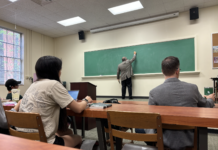In this day and age, we as journalists find ourselves having to defend our stances and face increased scrutiny. Because news outlets are desperately trying to fully represent their audience, we see more and more newsrooms aiming to include more diverse applicants in their team. While the term “diversity” is often associated with socioeconomic and ethnic background, newsrooms should also strive to incorporate reporters with diverse political perspectives and life experiences.
We have seen a rapid increase in minority journalists in the last few years. According to the 2018 diversity survey conducted annually by the American Society of News Editors, 22.6 percent of newsroom employees were part of a racial minority, up from 16.5 percent in 2017. The same survey showed that over one-third of newsroom managers are women at 41.8 percent, which saw its numbers increased from both 2017 and 2016.
Here at the Lariat, we always strive to embody the diversity of our university in our newsroom. This semester, however, we have experienced a less ethnically diverse applicant pool despite our efforts to reach multiple facets of the Baylor community. We are committed to hiring staff with diverse ethnic backgrounds as well as unique voices and life experiences.
Even with this drive (and results) for increased diversity among journalists and newsroom employees, there is still a massive problem with how news organizations are connecting with the American public. According to the Knight Foundation, a staggering 69 percent of U.S. adults have experienced decreased trust in the news media over the last decade. These numbers deeper suggest 75 percent of independent voters and 94 percent of Republicans have lost trust in the news media as well, with more moderate offerings from Democrats (42 percent) and liberals (46 percent).
The answer as to why diversity is going up, but trust is still going down is not one built on racism, sexism or any type of bigotry on the behalf of news consumers. Instead, the answer lies within the process of how news organizations seek diversity. They may look for differences in appearances, trying to meet quotas for women and racial minorities, instead of looking for differences in opinion.
In a look at the 2018 media bias chart constructed by Ad Fontes Media, six of the top 10 most widely circulated newspapers in the nation appear on the chart, with five of those six showing a left political lean. Suffice it to say, the news media that reaches the most people in this country is left-leaning, leaving the people who do not support the party targeted in these media outlets feeling under-represented. Newsrooms are trying to make their staffs reflect the way their audiences look, not the way their audiences think.
In this era of instant news and extensive commentary, so much of a news agency’s appeal is driven by its opinion and personalities as if to separate from the unending competition. The problem that most have run into, however, is that they have the same opinions on all matters, and their personalities are likely to say the same things that the rest of their competition is going to say. This leaves so little room for argument and growth.
Do not be mistaken, ethnicity and race are, and should be factors in every newsroom. There is, however, something to be said for hiring people based on differing experience, educational backgrounds and socioeconomic situations as well. It is time for news organizations to start looking past appearance for diversity, instead looking toward diversifying the defining characteristic that got journalists further than anything else: their experiences.






